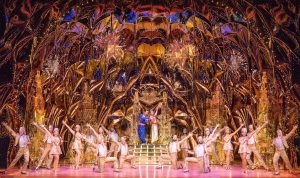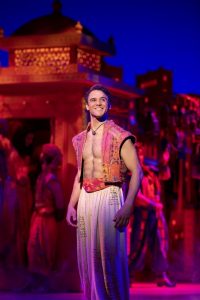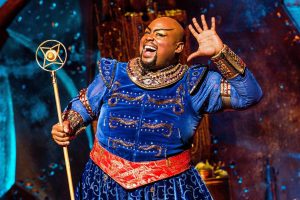Disney Meets Islam Fantasy and the Winner is that Magic Carpet
“Just call me Al,” pipes the jaunty hero of the Walt Disney musical Aladdin, touring through the Civic Theatre through March 3, and off we go.
There are plenty of gags not included in this bright, breezy, whizzbang show but I can’t remember what they are. Few opportunities for word-play, slapstick, innuendo, hip topicality, cool attitude or dazzling tricks are allowed to escape unpunched.

Just another of the numbers in the Walt Disney version of Aladdin, on tour at the Civic Theatre. Deen van Meer Photos
What there’s not much of, is story. Scripter Chad Beguelin seems to assume everybody knows that the penniless beggar will get the princess with the aid of the genie from the lamp. Also scarce are songs that move the story along. Alan Menken, Howard Ashman and Tim Rice understand that production numbers (and maybe a couple of soppy ballads) are what the audience wants and that’s what they supply, as rousing or sentimental at the moment as they are forgettable a little later.
Some of those names may be familiar, since they are stalwarts of the Disney empire experienced at molding folktales into fantasy films and Broadway extravaganzas. This particular project is just one part of a multi-media Disney milking of the Aladdin story, itself a latecomer to the traditional Mid-Eastern conglomerate usually known as “A Thousand and One Nights.”
(Fascinating subject that, though not especially relevant here. With assist from Wikipedia, I can say it’s a collection of tales dating back to 8thCentury Persia about the king who decides he must have a new virgin bride each evening only to execute her the next day. Scheherazade volunteers for duty and tells the king a tale without end, so he is forced to continue sparing her to hear the rest. The crafty girl extends the story for 1,001 nights until the king surrenders and they live happily ever after. Over the centuries, stories from India, Arabia, Syria, Egypt and so forth were pasted into the basic myth. Aladdin, along with Al Baba and Sinbad, were added in the first European translation, early in the 18thCentury, and the collection of adventure, humor, sex, horror, crime, fantasy and poetry has generally fascinated Western readers more than anybody in Islam. Penguin published a fairly definitive three-volume translation in 2008. But there’s little to suggest any of this was very useful to the folks at Disney.)
The supporting heroes of this show are director/choreographer Casey Nicholaw, a San Diego kid who has made real good, and Bob Crowley, the multi-talented Brit who did the gorgeous scenery on this occasion.
But the best-of-show ribbon goes to whoever designed the Magic Carpet, an effect that may be superior to anything I’ve seen in my own 1,001-plus-plus nights at the theatre. It exceeds even real good spectacle stage magic because it’s casually integrated into the script as if such amazements were just part of another day at the office.
Crowley, rejecting any notion that the rigid Islamic visual-art tradition of abstract patterns is a problem, instead embraces the visual vocabulary to ravishing effect both subtle and splashy. Greg Barnes’ costumes, which just keep on coming from some galaxy of glitter – harem pants, hairy chests, shiny texture and those sweet pointy shoes – are like a fireworks show done in fabric.
Nicholaw is just back from the Dollar Store of dance moves with a sinewy troupe of multi-cultural quick-change artists game for whatever. It’s like a food fight at a spaghetti supper: whatever sticks to a surface stays there. You can just hear the rehearsal: “Hey Casey! How about this…?”
And it’s nice to see what a decent budget can do for a touring show. Lighting designer Natasha Katz has superior bursts and blackouts at her disposal, coordinating the smoke pots, confetti guns and strobes with, I guess, the “illusion designer,” Jim Steinmeyer, for magic caves, busy marketplaces and a stupendous twinkly-night sky drop backing the magic carpet.
The budget shows in the orchestra pit, too, where Faith Seetoo’s 14 musicians frolic along through the richly knowing orchestrations by Danny Troob, who can casually quote other Menken Disney songs and even West Side Story’s mambo without breaking stride.
The way to approach casting for this show is to find your Genie and then stand clear. Major Attaway looks like a vintage TV commercial who no longer counts calories but he throws his bulk around like Zero Mostel, sings with the confidence of Pavarotti and sports a smile that’s pure vintage Buick. The plot has him fleeing to freedom before the finale but, come on! He’s back in time to dominate the scene as he has every other one he gets near.
Clinton Greenspan is a jaunty Aladdin with pecs so prominent that they set up a gag: “I’d give the shirt off my back…” “You’re not wearing a shirt!” Lissa deGuzman is game but forgettable as the princess in question; Erik Hernandez is ditto as her dad, the sultan.
Any stage air not occupied by the Genie belongs to scenery-chewing Jonathan Weir, the scheming villain, who brandishes a divine magic staff (basically a full-length cobra) and spares crumbs of mugging ops for Jay Paranada as his plump toady (named Iago?). A trio of beggar bros for our Al are played with endlessly flexible ‘tude by Zach Bencal, Philippe Arroyo and Jed Feder.
The Disney product may be from the predictable formula but that’s what the public wants, I guess. Certainly, it’s done with respect for the various crafts involved.
Art? Well that’s nice if the seats keep filling up with butts.
(Continues in the Civic Theatre through March 3, 2019.)

Welton Jones has been following entertainment and the arts around for years, writing about them. Thirty-five of those years were spent at the UNION-TRIBUNE, the last decade was with SANDIEGO.COM.




